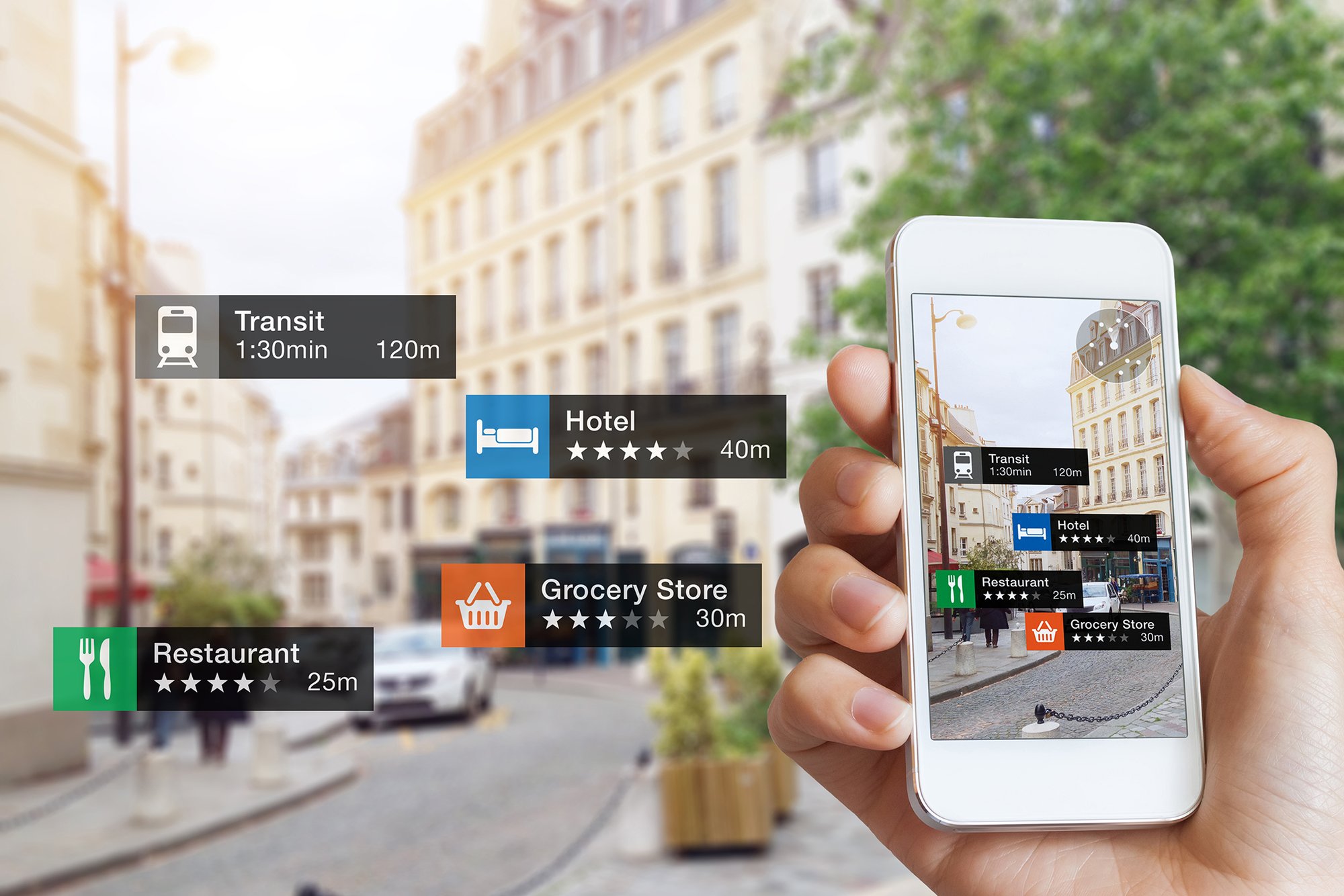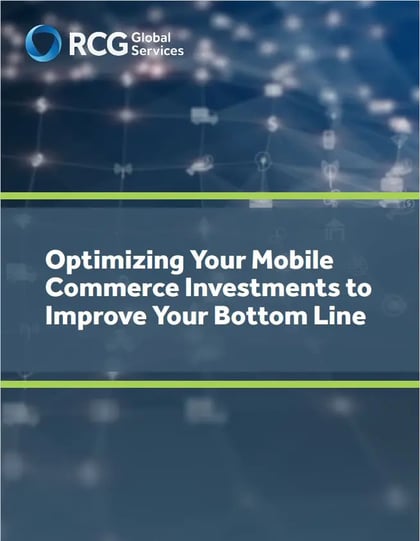Optimizing Mobile Commerce to Improve your Bottom Line
Organizations must adapt to the new rules that consumers live by in order to continue to grow and stay relevant to their customers.
The Consumer Marketplace has Evolved - It’s a Mobile Commerce Economy

While many customers now expect a mobile commerce experience, creating a mobile app or website can be expensive, requires investment and comes with its own set of challenges.
The events of 2020 have dramatically accelerated this rate of change. Organizations must adapt to the new rules that consumers live by in order to continue to grow and stay relevant to their customers. Now is the time to review your mobile commerce strategy to ensure that it reflects the “new normal” that we live in and provides a foundation for future growth.
E-commerce is a generic term that covers all sorts of commerce activities that can include online catalogs, web sites, social media selling, and other sales that are tied to hosted services, mobile commerce focuses explicitly on the sales that have been started or completed on mobile devices (phones and tablets).
“Over 125 million users own some kind of smartphone that they often use more than a desktop. 62% of those users have made purchases on their mobile devices over the past 6 months.” – Outerbox Design
As the capabilities of mobile devices become more sophisticated and on par with desktops – more people are using them as their primary devices during the workday and beyond. Mobile shopping is taking over the holiday shopping events (like Black Friday) that have been typically dominated by the brick and mortar stores.
Here are some statistics from the holiday shopping season in the U.S. in 2019 :
- The National Retail Federation reported that more than 174 million Americans shopped from Thanksgiving through Cyber Monday, which beat the association’s pre-holiday prediction that 164 million consumers would indulge. – via Forbes
- The 174 million Americans who shopped between Thanksgiving Day and Cyber Monday spent an average of$335 per person during that five-day period. – via The Washington Post
- About 58 million people shopped online only, while 51 million shopped exclusively in stores. The remaining 65 million consumers shopped both online and in-store, meaning 116 million Americans left home to spend time and money in brick-and-mortar retailers. –via Forbes
- According to accounting firm Deloitte, 50% of this year’s holiday shoppers now say they prefer online shopping to brick-and-mortar, with just 36% saying the opposite. Roughly 55% of shoppers tell Deloitte they’ll be shopping online this year, with 44% going to discount stores and 28% going to department stores. –via The Street
- The multichannel shopper spent $82 more on average than the online-only shopper and $49 more on average than those shoppers who only shopped in stores. – via The NRF
- American shoppers spent a record $5 billion in 24 hours. That marks a 16.9% increase in dollars spent online compared with Black Friday 2016, according to data from Adobe Digital Insights, which tracks 80% of online spending at America’s 100 largest retail websites. – via CNN Money
- Retail sales for the first two weeks of the holiday shopping season are up 6%across general merchandise categories, according to market research company NPD, but much of the spending has been on things consumers want for themselves rather than what they’re buying as gifts for others. – via The Street
- Over the holidays, 48% of the entire U.S. online apparel retail market was discounted by an average of 45% off, compared to 44% of the market with an average of 36% off last year. – via retail analysis firm Edited
- Luxury brands got in on the discounting game more than ever before. For example, almost a quarter of luxury handbags for sale online have been marked down between 40 percent and 50 percent so far, up from 30-40%last year, Edited said. It named Fendi, Balenciaga, Tom Ford and Prada as some of top discounted brands. – via Bloomberg
- The biggest spenders, millennials aged 24 to 35, paid out an average of $419.52 per person. – via The Washington Post
In 2021, smartphone retail e-commerce sales in the United States are projected to surpass $345B, up from $148B in 2018. Despite the impressive gains and projections, the mobile shopper conversion rates in the United States are still lower than other digital shopping platforms. Improving the conversion rate from “browse” to “buy” is a key metric to track and gauge the progress being made and the return on the investment expended.
It is clear that mobile commerce is not just a fad and has become an essential part of an organization’s business strategy. But simply having a mobile commerce capability doesn’t mean that it will be cheap to operate, easy to use, or drive the expected revenue. It is essential to review every step of the various customer journeys and configure the user experience to match how people are most likely to use their mobile devices with your organization.
Challenge and recommendations

One of the drivers for this is that mobile applications have a dedicated place on the mobile device’s screen as opposed to a link in someone’s favorite list. Mobile users can log into your application using the built-in facial recognition or biometric scanner, giving the impression of enhanced security. Many organizations have built mobile applications or mobile websites over the past few years, but now they are looking to optimize their investments to reduce operating costs and increase revenue generated. Typical challenges that many organizations encounter can easily be mitigated to improve their mobile ROI.
Challenge: Supporting multiple mobile platforms
“The rich and interactive experiences we have come to expect on mobile apps have created new standards and expectations for all digital media, including the web. The result is websites are evolving to become more app-like in their rich functionality.” – Raj Aggarwal, CEO of Localytics
Traditional native mobile app development for a single application on multiple platforms is costly and time-consuming. While the features and functionality are intended to be the same, the mechanisms to implement them are different for iOS and Android due to the variances in platforms, languages, and user interface conventions. Designs that are dependent on system provided services like address books, calendars, cameras, and payment platforms will also cause special case considerations, further resulting in divergent code bases.
Several factors come into play when a decision is made to use a native application approach versus a cross-platform approach such as React Native, Ionic, or Flutter:
- User experience and user interface conventions that are unique to each native platform
- App performance and speed
- Support for custom functionality thru platform-specific frameworks -i.e., indoor mapping or graphics frameworks
- Speed of integrating new platform features
- Level of device-specific optimization
Supporting multiple platforms with native code can be expensive – VERY expensive. Aside from the extra expense of having to build up two separate teams to support your different codebases, there are many more examples of expenses that are not as apparent. For instance, while the requirements and back-end support services should be re-usable across platforms – user interface code and even test automation scripts usually must be customized per platform. Continuous build and deployment scripts are also platform-specific and must be maintained separately. Instrumenting different versions of a mobile application to track user behavior can also run into challenges if the same analytics tags are not applied in the same way between platforms – either due to changes in design or oversight. This will result in data cleanliness that is hard to reconcile across applications.
All of these things result in additional development and testing time required to complete every user story. More time equals more money.
The total cost of ownership MUST be considered as part of the decision making regarding the future direction of your mobile strategy. While native code-based applications may meet your requirements from a functional perspective, does it make economic sense based on the value that the applications generate for your organization?
Recommendation to Improve the ROI of your Multi-platform Mobile Strategy
While it is important to focus on the user experience for each platform and try to minimize exceptions to common user interaction patterns for the platform, it is more important to focus on creating user journeys through your applications that don’t rely on specific platform capabilities unless it is crucial in differentiating your product or service in the marketplace.
There may be examples where a native platform user experience is essential to justify the total cost of ownership, but most companies will struggle to realize the ROI over the average life of a typical mobile application (~1-2 years).
Consider these recommendations to improve the overall ROI of your multi-platform enterprise mobile application strategy:
- Review the feature set of your application to identify every platform-specific feature to see if it is absolutely needed to justify the total cost of ownership (TCO) required to maintain it. Examples can include Apple Pay, Apple Wallet, or multiple Android App Stores. Every platform-specific feature must be rationalized to determine whether it is actually being used and generates business value to your organization. If you don’t have usage metrics, instrument your application to find out immediately.
- Move to a cross-platform strategy if less than 20% of your features depend on platform-specific capabilities or can be refactored to take advantage of a cross-platform framework. The implication is that your application may not be able to take advantage of the latest platform-specific features as soon as they come out, but that might be a good thing unless your company is either Apple or Google. Most business processes don’t change quickly enough to justify investment in bleeding-edge technologies. Even features that require platform-specific features can be incorporated into cross-platform frameworks using their built-in “hook” technologies designed to embed native modules for this purpose. Having small amounts of native code in a cross-platform based application is still cheaper than building two completely separate code bases.
- Move the “heavy lifting” business logic of your applications and business processes into your services code. Strip out every possible piece of business logic from your mobile applications to turn the user interface into a simple shell to convey data to and from the service layer. Ideally, only the logic required to transmit user interactions back and forth to the services should remain when you are done.
- Invest more heavily in test automation for the back-end services. These services are the critical layer of your application. The front-end user interfaces should be considered disposable and easy to replace as opposed to the back-end services that do the “real work.”
Moving to a cross-platform mobile strategy may require you to upskill your existing workforce or replace your contractors with a different skill set. The reduction in long term total cost of ownership can easily and quickly recover the investment while resulting in a more stable and easier to manage codebase.
Challenge: Consistent customer experience across all delivery channels
Track every customer touchpoint. Collect data to identify individual personas. Make sure they’re on the correct path and use that data to programmatically scale amazing experiences across the entire customer lifecycle.” – Mathew Sweezey, Principal of Marketing Insights at Salesforce
Consumers are quickly embracing new digital channels to interact with their favorite brands. Customers want to be able to reach your brand on the channel that is most convenient for them. One of the critical challenges for an organization is how to deliver a seamless customer experience across digital channels. Too often, the customer experience evolves and is not consistent across channels. A customer’s impression of your organization is only as good as the last interaction they have with you. One hundred great experiences will be erased with a single bad one.
While online shopping continues to grow, the customer is only seeking the best and most convenient experience for themselves. Customers are looking for the best of both online and in-store options by visiting stores to check out products before purchasing online or purchasing online and picking items up from the physical store. The retailer must deliver a great customer experience across every channel — in-store, online, and mobile.
70% of consumers say technology has made it easier than ever to take their business elsewhere” – Salesforce
Your organization’s mobile strategy must focus on the way that customers are interacting with you today – not how they interacted with you last year. Technology and customer attitudes are continually changing and must be re-examined regularly.
Outside of purchasing based transactions, customer service interactions are the next highest set of interfaces between a customer and the organization. Making it easy to buy products and services from a company only helps the first transaction. Providing exceptional customer service for today’s transactions encourages and enables tomorrow’s transactions.
According to Forrester, “95% of consumers use three or more channels in a single customer service interaction, with 62% of them crossing devices.”6
Organizations realize that today’s customer is inundated with choice, and therefore, these organizations recognize that they cannot rely on unique selling points or distribution channels. The company’s competitive edge in the marketplace is shaped by the quality of consistent customer experience in all delivery channels. People are engaging with a brand or a service through websites, mobile apps, and social media platforms, and in a brick-and-mortar stores. So, companies must have an omnichannel plan that focuses on prioritizing customer relationships and buying experiences at every touchpoint.
Recommendation for an Effective Omnichannel Delivery Strategy
Building an effective omnichannel delivery strategy is critical to business success with the millennial generation. They are not constrained by the choices their parents made, and they are not loyal to the traditional brick and mortar stores that populate vanishing shopping malls. This new generation of consumers are used to the Information Age where the knowledge of all mankind is available in the palm of their hand. Consider these recommendations for implementing an effective omnichannel delivery strategy for your mobile-first customers.
- Rationalize each delivery channel your customers use to connect with your products, services, or customer support organization. Perform a gap analysis of the most used features from each channel and compare the user experience to ensure that they are equivalent in effort expended to the benefit received across every delivery channel. Prepare a plan to close those gaps as soon as possible. The priority should be focused on optimizing the customer experience not on the cost to the organization.
- Don’t focus on replicating the brick-and-mortar experience in the online world. While it may feel comfortable, you may be imposing unnecessary limitations that will take away from the overall user journey. Instead – take the lessons learned from the online world and work to optimize the real-world processes to match. This approach has the side effect of helping to eliminate outdated impediments to customer satisfaction that were primarily rooted in the inefficiencies of old technology and workflows.
- Mobile adds another dimension to the shopping experience. If you’re not interacting with customers via mobile, this is a great time to engage them through a loyalty program. Ask for their preferences about how they would like to be contacted (text, voice, social media, etc.), and be prepared to respect their choices. Furthermore, make sure the mobile experience is consistent with the customer experience on other platforms and consider augmenting a store visit with the mobile experience. Be sure to share your knowledge of customer preferences with the other delivery channels (phone and web), so the user experience remains consistent at a minimum.
Challenge: Continuous support burden from new hardware and software
Mobile hardware capabilities are rapidly advancing as manufacturers find ways to push the limits to what’s possible with a mobile device. Companies like Apple and Samsung launch new devices every year with upgraded hardware and software features with advanced technology features that drives buyers to upgrade their devices – and in many cases providing compelling financial incentives to do so. This continuous upgrade cycle of hardware and software has implications for an organization’s mobile application portfolio that drive the total cost of ownership.
At a minimum, it is necessary to purchase the new device and validate that the old applications still work as expected. In many cases, however, there are new features or form factors that require updates to the software to remain compliant with the expected user experience for the platform. An example of this was when Apple introduced the “notch” at the top of the iPhone X to accommodate a higher resolution front-facing camera. This required updates to many applications to handle the new screen geometry properly. Cross-platform development frameworks like React Native do NOT eliminate the need for testing on multiple hardware devices. While most functionality can be tested using emulators, certain features like GPS or accelerometers can only be tested on physical hardware devices.
There are many examples of new features in devices driving new capabilities for business applications. Consumers were quick to move to mobile payments when the NFC technology was first introduced for making electronic payments at credit card terminals, and now it is common to incorporate mobile payments into business applications using the same frameworks. These technology updates often provide additional features that consumers find useful and become popular that drive an organization to include as a part of their service offerings.
Hardware updates can have a significant impact on the entire mobile application development lifecycle. Every new iteration of a device adds to the regression testing burden to ensure backward compatibility. Today, the battle for hardware supremacy has shifted to other high-level functionality like display size and quality. For application developers and mobile testers, the challenge is to ensure applications can adapt to the various types of displays on mobile devices. This means that the content needs to be shown within the right boundaries so that user interaction is not hampered.
The implication of security is one of the critical aspects while adapting to the latest technology upgrade. Features have moved from unlocking a screen using a PIN/pattern to biometric sensors and face recognition. So, mobile app developers are leveraging these new upgrades to give secure access to mobile apps.
Organizations are challenged to implement additional support and to absorb additional costs due to hardware and software upgrades. To stay up-to-date with new trends and to take advantage of the latest hardware and software upgrade is a tough balancing act.
Recommendations for Controlling Hardware and Software Costs
Over time, the cost burden of purchasing new hardware for development and testing purposes can add up. A new phone can easily cost $1,000. If you have a team of developers and testers, you may have to purchase $10,000 worth of new hardware each year. All of the new hardware updates also add to the regression testing burden. On average, people upgrade their phones every 18-24 months, meaning that an organization needs to support the last 2 or 3 versions of the hardware devices for ALL of the manufacturers supported. On the Android platform, Samsung is the market leader, with approximately 20% of the total market. Most enterprise applications are tested against Apple iPhone and the latest Samsung Android phone as opposed to a large suite of hardware vendors.
To reduce the overall burden of supporting multiple platforms, consider the following actions:
- Defray the cost of having to buy lots of expensive hardware to support your teams by subscribing to a device farm such as Sauce Labs (https://saucelabs. com/) or Amazon Device Farm (https://aws.amazon.com/device-farm/). This helps to configure support for various combinations of operating systems and hardware devices. This can come in handy when trying to replicate a customer issue that may have been outside of your original certification plan.
- Develop a full suite of test automation scripts for each platform that can be used to execute a reliable regression test across all the supported devices and operating system combinations at once (ideally using your device farm). It is cheaper in the long run to update a test suite than it is to do continuous manual testing for every supported platform combination.
- For internal applications or environments where it is possible to restrict the users to a specific platform or hardware device – make a conscious decision to deprecate support for the other platform and eliminate the unneeded option.
The actual cost of creating software for multiple platforms is much higher than the initial coding effort; the ongoing cost of ownership of multi-platform applications can be significant over the life of the application.
Challenge: Converting new technologies into profitable business models
“Some people say to give the customers what they want, but that’s not my approach. Our job is to figure out what they’re going to want before they do. I think Henry Ford once said, ‘If I’d ask customers what they wanted, they would’ve told me a faster horse.’ People don’t know what they want until you show it to them. That’s why I never rely on market research. Our task is to read things that are not yet on the page.” – Steve Jobs
An important challenge organizations face involves their digital maturity and their ability to pivot from their current position to quickly adapt and transform with new technologies to enhance their business outcomes. Digital transformation involves utilizing digital technologies to revamp, rewrite, or replace a process to be more efficient or effective. Technology enhancements are helping companies to develop new business models and disrupt the established way of running operations. Companies see tangible value in adopting the latest technologies as it improves their product optimization, improving productivity, and tracking operational efficiency challenges.
Today’s consumer’s behavior focuses on ease-of-use and speed. The millennial generation has integrated technology very deeply into their lives – from the online ordering of food to the people that they meet and marry. Technologies that were initially developed for one purpose can often be adapted for other purposes – opening up whole new markets or processes to change. Near Field Communication (NFC) is a perfect example. Most people associate mobile payments on their phones and services like Apple Pay or Google Pay with NFC; however, the same technology has been used for enabling door locks, inventory management, and interactive displays – the possible uses are nearly boundless. Successful companies need to understand the broader picture of how to apply new technologies to solve problems you weren’t even aware you have.
Advanced technology also allows businesses to find new ways to use their distribution channels. A business that can offer an improved service and eliminate barriers or improve customer service for a user can be successful in the market. Presently, organizations are taking advantage of new technologies in mobile app development for their version of “the secret sauce”; the results are cascading throughout almost all industries and pushing them
to come up with innovative, digital solutions based to improve and enhance their customers’ experiences.
It is difficult for some organizations to redesign their business processes because they are too married to them and can’t see past the way it has always been done train of thought. Recreating antiquated processes in a new technology may provide incremental improvements. But, it’s not the technology that transforms the business; the technology enables enhanced, improved, and new business models and ecosystems.
According to a survey conducted by Grant Thornton, more than two-thirds (69%) of CFOs and senior financial executives are planning to increase their investment in technologies that speed business change. Historically, companies invested in technology upgrades, remaking individual functions such as sales support and customer service, but a clear majority of companies now invest in digital transformation for long-term growth, not short-term improvements.
Companies embracing new technologies should identify the troubling gap between the inherent value of the latest technology and their ability to put it to work effectively to achieve measurable business outcomes.
Recommendations for Profiting from Digital Transformation
Technology empowers organizations to grow faster and serve their clients more efficiently. Companies need to keep abreast of the new technology to improve business outcomes. To attain growth, it is essential to have a strategy that defines the role of technology performs within the organization. Once the strategic role that technology plays within an organization is defined, the search for the correct implementation is easily manageable.
The importance of cross-training between the technologists and the product managers on the new technologies enables a clean sheet of paper approach to solving problems differently. Many companies choose a product and implement it across the organization based on product materials and demonstrations. It is a better approach to implement it in a small group of employees or departments that yield insights about the product.
Assigning budgeted dollars for research into new technologies and partnering with a technology consulting and implementation company is necessary for organizations to remain updated on technologies.
Accelerate Your Mobile Strategy Implementation to Realize Your Business Goals

In 2019, Amazon reported that 85% of mobile activity came through their app versus their web site. Adopting a mobile-first approach to your commerce strategies is a substantial justification for investment. Being successful in your plans requires significant investment in time and planning to ensure that the investments are made in the right places at the right time to improve the right things.
RCG has the background and experience to help you in those decisions.
Works Cited
- https://www.pixlee.com/blog/10-stats-from-black-friday-and-cyber-monday/
- https://www.statista.com/statistics/276636/smartphones-us-retail-m-commerce-sales/
- https://www.statista.com/statistics/234884/us-online-shopper-conversion-rate-by-device/
- https://deviceatlas.com/blog/how-regularly-do-people-upgrade-their-smartphones
- https://www.outerboxdesign.com/web-design-articles/mobile-ecommerce-statistics
- https://www.zendesk.com/blog/forrester-engagement-costs-continue-rise-even-digital-heres-fight/
Download a PDF version of this ebook by filling out this form


